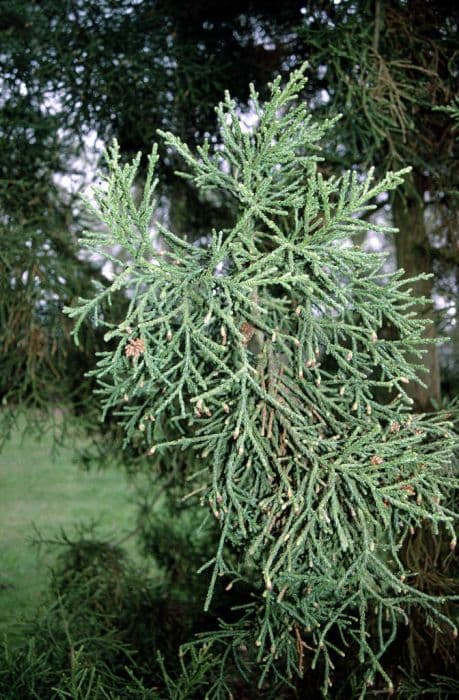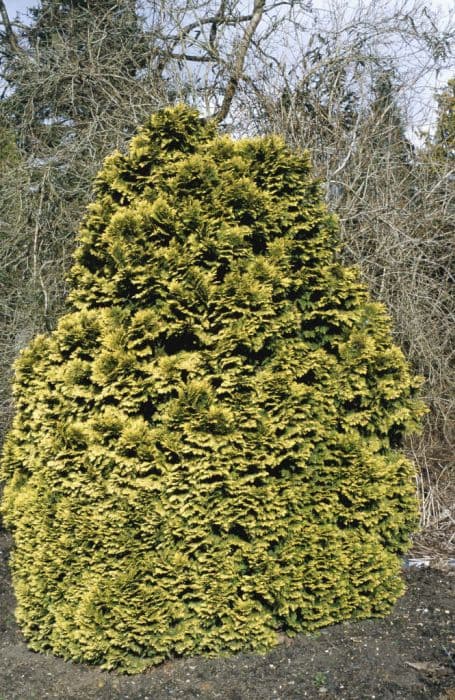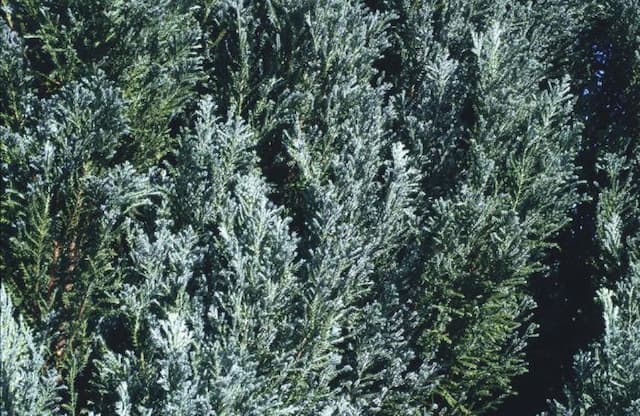Dawn redwood 'Golden Oji' Metasequoia glyptostroboides 'Golden Oji'

ABOUT
'Gold Rush' is a deciduous conifer of narrowly conical outline when young, with soft, flat needles that are bright yellow when young, becoming greenish-yellow with age and turning dull yellow to buff in autumn
About this plant
 Names
NamesSynonyms
Dawn Redwood, Gold Rush Dawn Redwood
Common names
Metasequoia glyptostroboides.
 Characteristics
CharacteristicsLife cycle
Perennials
Foliage type
Deciduous
Color of leaves
Golden
Height
50 feet (15 meters)
Spread
15 feet (4.5 meters)
Plant type
Tree
Hardiness zones
5
Native area
China
Benefits
 General Benefits
General Benefits- Ornamental Value: The Dawn Redwood 'Golden Oji' is highly valued for its stunning golden-yellow foliage that stands out in the landscape.
- Seasonal Interest: It provides year-round interest with its foliage, which transitions from golden in the spring to deep copper in the autumn before shedding in the winter.
- Shade Provision: With its large stature and dense foliage, the Dawn Redwood 'Golden Oji' offers considerable shade during the hot summer months.
- Wildlife Habitat: Its structure provides nesting sites and habitat for birds and other wildlife.
- Erosion Control: As a fast-growing tree with an extensive root system, it helps stabilize soil and prevent erosion.
- Low Maintenance: Once established, this variety of Dawn Redwood requires minimal care, making it suitable for large landscapes and parks.
- Climate Adaptability: It is adaptable to a range of climatic conditions and can withstand cold winters.
- Historical Significance: The tree is a living fossil, with a lineage stretching back to ancient times, providing educational and historical value.
 Medical Properties
Medical PropertiesThis plant is not used for medical purposes.
 Air-purifying Qualities
Air-purifying QualitiesThis plant is not specifically known for air purifying qualities.
 Other Uses
Other Uses- The wood of the Dawn Redwood can be used in the creation of musical instruments, such as soundboards for guitars, due to its acoustic properties and aesthetic appeal.
- Dawn Redwood bark can be utilized in landscaping as a decorative mulch, providing a rustic look while also helping to retain soil moisture.
- The fallen leaves of the Dawn Redwood offer a natural fertilizer as they decompose and enrich the soil with nutrients.
- The tree's fast growth and large size make it suitable for use as a windbreak in agricultural or large residential areas.
- In bonsai, the Dawn Redwood can be trained to create miniature landscapes, showcasing its distinct coniferous features in a small scale.
- The tree’s unique appearance, with its flared trunk base, is a popular subject for photographers and painters who focus on natural landscapes and botanical themes.
- Woodworkers may use small branches and the soft, workable wood of the Dawn Redwood for crafting ornaments and intricate carvings.
- Leaves from the Dawn Redwood can be used in compost bins to add carbon-rich material that helps improve compost balance.
- Some artisans use thin slices of the tree's wood to create veneers for decorative woodworking and inlays for furniture making.
- The distinctive winter silhouette of the Dawn Redwood, with its needle-less, stout branches, can be leveraged in designing dramatic lighting effects for nighttime gardens or parks.
Interesting Facts
 Feng Shui
Feng ShuiThe Dawn Redwood is not used in Feng Shui practice.
 Zodiac Sign Compitability
Zodiac Sign CompitabilityThe Dawn Redwood is not used in astrology practice.
 Plant Symbolism
Plant Symbolism- Renewal: As the dawn redwood is a deciduous conifer, which is rare, it sheds its needles in the fall and regrows them in the spring, symbolizing new beginnings and renewal.
- Resilience: Having been thought extinct but then rediscovered, the dawn redwood is a symbol of resilience and survival against the odds.
- Longevity: As a species that has existed for millions of years, the dawn redwood represents endurance and the passage of time.
- Peace: The gentle appearance and feathery foliage of the dawn redwood can be seen to represent tranquility and peace.
 Water
WaterThe Dawn Redwood should be watered deeply and thoroughly, which means the soil should be moistened to a depth of 12 inches. In the active growing season, usually spring to fall, it will need watering once or twice a week, depending on the climate and weather conditions. If you're using a garden hose, this might mean watering for 15-30 minutes, which could roughly translate to about 10 gallons of water per session. During the winter or in rainy periods, reduce the frequency as the tree requires less water. It's important to avoid waterlogging, so ensure proper drainage is in place.
 Light
LightThe Dawn Redwood thrives best in full sun exposure, meaning it should receive at least six hours of direct sunlight each day. Planting the tree in an open space away from larger structures or trees that may shade it will ensure it gets sufficient light. While the tree can tolerate some shade, growth and foliage quality are optimal when it receives plenty of sunlight.
 Temperature
TemperatureThe Dawn Redwood is tolerant of a wide temperature range, enduring cold down to about -20°F and heat as it is commonly resistant to summer temperatures typical of many growing regions. However, the ideal temperature range for this tree is between 50°F and 80°F for optimal growth. Dawn Redwoods are cold-hardy and can withstand freezing temperatures, but growth will slow down significantly when the temperature dips below the ideal range.
 Pruning
PruningPruning the Dawn Redwood promotes healthy growth and maintains its desired shape. The best time to prune is in late winter to early spring before new growth begins. Remove any dead, damaged, or diseased branches, and thin out areas of dense growth to allow sunlight and air to penetrate the canopy. Typically, an annual pruning session is sufficient, but always use clean, sharp tools to make precise cuts.
 Cleaning
CleaningAs needed
 Soil
SoilThe Dawn Redwood prefers a moist, well-draining soil with a mix of peat, loam, and sand. It thrives in a slightly acidic to neutral pH range, around 5.0 to 7.5. Amend heavy soils with compost to improve drainage.
 Repotting
RepottingDawn Redwoods, being fast-growing trees, may need repotting every couple of years when young or grown in containers. Monitor root growth and repot to prevent root-bound conditions.
 Humidity & Misting
Humidity & MistingDawn Redwoods are adaptable but prefer a moderate to high humidity level, reflecting their native wetland habitat. They tolerate average outdoor humidity well.
 Suitable locations
Suitable locationsIndoor
Insufficient space indoors; not ideal for house growth.
Outdoor
Plant in full sun, ensure ample space for growth, and water regularly.
Hardiness zone
4-8 USDA
 Life cycle
Life cycleMetasequoia glyptostroboides 'Golden Oji', commonly known as Dawn Redwood, is a deciduous conifer. The life cycle begins with seed germination that occurs in moist, well-drained soil in the spring. Seedlings quickly establish a taproot and exhibit rapid growth, transitioning into saplings with a characteristic pyramidal shape. As they mature, Dawn Redwoods reach reproductive age and develop cones; male cones produce pollen while female cones develop seeds. These trees can live for hundreds of years, during which time they may reach over 100 feet in height. Eventually, older trees might experience reduced growth and reproductive output before naturally declining and dying.
 Propogation
PropogationPropogation time
Late Winter-Early Spring
The Dawn Redwood 'Golden Oji', scientifically known as Metasequoia glyptostroboides 'Golden Oji', is primarily propagated through the method of semi-hardwood cuttings. This propagation is preferably undertaken during the later part of summer when the current season's growth has begun to mature and harden slightly but is not fully woody. To do this, one identifies a healthy branch and cuts a segment about 6 to 10 inches (15 to 25 centimeters) long. The cuttings should have several nodes, which are the points where leaves are attached, as these are the areas from which roots tend to grow. The lower leaves are removed and the cut end is treated with rooting hormone powder to stimulate root growth. Then, the cutting is placed into a moist potting mix and kept in a warm environment with high humidity. By maintaining appropriate moisture levels and waiting several weeks, the cutting should develop roots and can be gradually acclimatized to outdoor conditions before being planted in its permanent location.









